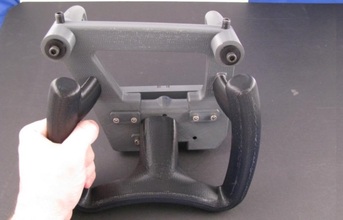
Rapid prototyping has become a standard practice in product development. At the BMW AG plant in Regensburg, Germany, FDM (fused deposition modeling) continues to be an important component in vehicle design prototyping. But moving beyond prototyping, BMW is extending the application of FDM to other areas and functions, including direct digital manufacturing.
The plant's department of jigs and fixtures uses a Stratasys 3D Production System to build hand-tools for automobile assembly and testing. According to engineer Günter Schmid, "BMW has determined that the FDM process can be an alternative to the conventional metal-cutting manufacturing methods like milling, turning, and boring." Schmid and fellow engineer, Ulrich Eidenschink, have shown that financial advantages include cost reductions in engineering documentation, warehousing, and manufacturing.
For hand-held devices used on the assembly line, engineers have discovered that there are even greater advantages that arise from the design freedom that FDM offers. Capitalising on the elimination of constraints, Schmid and Eidenschink employ FDM to make ergonomically designed assembly aids that perform better than conventionally made tools.
Real solution
To improve productivity, worker comfort, ease-of-use, and process repeatability, the plant uses FDM to enhance the ergonomics of its hand-held assembly devices. The freedom of design allows engineers to create configurations that improve handling, reduce weight, and improve balance. According to Schmid, "The tool designs we create often cannot be matched by machined or molded parts."
In one example, BMW reduced the weight of a device by 72 percent with a sparse-fill build technique. Replacing the solid core with internal ribs cut 1.3 kg (2.9 lbs) from the device. "This may not seem like much, but when a worker uses the tool hundreds of times in a shift, it makes a big difference," says Schmid.
(Continued on the next page)


























